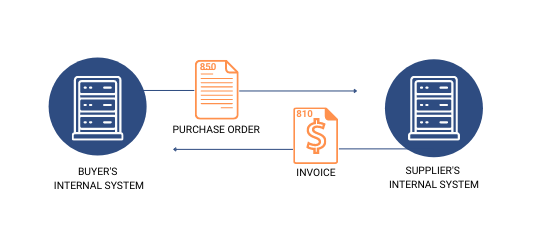Define EDI Compliance
EDI compliance refers to a business’s capacity to accurately send and receive EDI transactions according to the requirements of its EDI trading partners. Each document must adhere to a specific EDI format to ensure the successful exchange of EDI documents.
Why Do I Need to be EDI Compliant?
Today you would be hard-pressed to find a major retailer who does not make EDI trading a requirement to do business with them. The importance of becoming and maintaining EDI compliance can not be understated, especially given how much it benefits your bottom line.
Being EDI capable means your business can use EDI to transmit your basic business documents like Purchase Orders and Invoices to your trading partners.
EDI implementation issues can be costly and time-consuming. The cost of being non-compliant comes in the form of EDI chargebacks.
What are EDI Chargebacks?
EDI Chargebacks (also known as ‘Expense Offsets’) are financial penalties for non-compliance with your customer’s requirements. Customers issue EDI chargebacks because vendor non-compliance disrupts operations and creates an additional expense for the customer.
Every customer-supplier relationship agreement is different, EDI chargebacks can range from hundreds to thousands of dollars per violation, which can add up very quickly causing huge and avoidable loss of revenue on an annual basis. If you’re late or miss a delivery, packages are labeled wrong, or a shipment is damaged or incomplete, expect to receive an EDI chargeback.
Most Common EDI Chargebacks
The EDI 856 Advance Shipping Notice is one of the most common EDI documents to receive a chargeback. Most major retailers consider the EDI 856 a crucial component of EDI compliance. The EDI 856 is used to communicate the tracking and packing information of a shipment.
Furthermore, to the ASN errors, such as incorrect bar codes or labels, other common reasons that a customer may charge their vendor include:
- Missing or late delivery
- Invoice errors, such as sending duplicates or incorrect invoice totals
- Delivery to the wrong location
- Using the wrong shipping carrier
- Failure to meet proper packing specifications
EDI Compliance Requirements
Many companies have requirements for EDI trading partner setup and maintenance, both of which are important in keeping compliant. These requirements include but are not limited to, the ability to exchange the basic EDI document set, a timeline for testing, and specific connection requirements.
Here is a list of a couple of basic EDI documents that most retailers will require to be compliant:
- EDI 810 Invoice
- EDI 850 Purchase Order
- EDI 856 Ship Notice/manifest (ASN)
- EDI 855 Purchase Order Acknowledgement
- EDI 846 Inventory status
- EDI 860 P/O Change
How to Become EDI Compliant
There are a few important steps in the process to becoming EDI compliant.
View our Getting Started With EDI a 5 Step Process

1. Identify Requirements
You first need to understand the requirements of your specific trading partner. Most trading partners will have resources on their websites that detail the full set of requirements and expectations.
2. Select an EDI Solution
There are 3 main types of EDI solutions:
Internet EDI/ Web EDI – EDI web forms (such as Commport’s Internet EDI) – these solutions are hosted on the internet and are ideal for users that have a low volume of transactions or trading partners.
Integrated EDI Solution – Managed EDI (such as Commport’s Integrated EDI) – these solutions enable transaction integration. They rely on the solution provider to manage the EDI standards which allows the user to focus on their
business and system requirements.
Software and Services – These solutions rely on “edi translation software” which is often purchased and maintained on-premise. They rely on the user to be able to perform their own application and data mapping between the EDI translation software and their business system. Users that pursue an on-premise EDI translation software approach will also still require an EDI Services provider (Value Added Network or VAN) for communications otherwise they will also need to adopt some communications infrastructure to manage their relationships with their trading partners.
3. Implementation and Testing
Once you have selected a solution and a provider, work with that provider to implement the solution. Your next step is testing, you must test your EDI solution to ensure that the documents can successfully be exchanged in the proper format with your trading partner(s). Once testing has been completed and successful. You’re ready for business!
Conclusion
EDI compliance means, ensuring seamless electronic communication and collaboration within supply chains. Adhering to EDI standards and requirements is essential for organizations to efficiently exchange business documents, enhance operational efficiency, and maintain positive relationships with trading partners.
Need Help? Download: EDI Buyers Guide
Unlock the full potential of your supply chain with our comprehensive EDI Buyer's Guide — your first step towards seamless, efficient, and error-free transactions
Frequently Asked Questions
EDI Compliance refers to the adherence to Electronic Data Interchange (EDI) standards and requirements, ensuring that businesses can exchange electronic documents seamlessly with their trading partners in a standardized and efficient manner.
EDI Compliance is crucial for businesses as it streamlines communication, reduces errors in data exchange, accelerates business processes, and enhances overall operational efficiency. It also helps maintain consistency in transactions with various trading partners.
Yes, there are industry-specific standards for EDI Compliance, such as EDIFACT, ANSI X12, and others. These standards define the format and structure of electronic documents to ensure consistency and compatibility between trading partners.
Achieving EDI Compliance involves implementing EDI software or solutions that adhere to industry standards, collaborating with trading partners to ensure mutual compliance, and staying informed about updates and changes in EDI standards.
Non-compliance with EDI standards can lead to communication errors, delays in business processes, increased operational costs, and strained relationships with trading partners. It is essential for businesses to prioritize and maintain EDI Compliance to avoid these issues.




